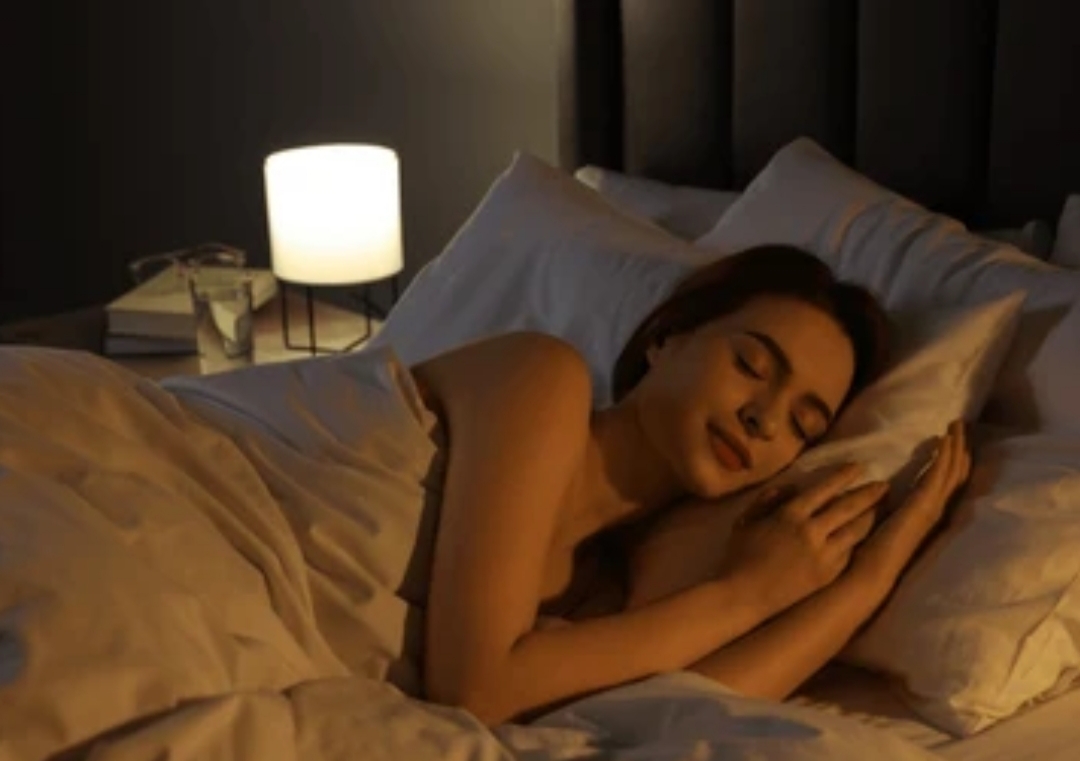🛌 Introduction – Why Smart Lighting Could Be the Missing Link to Better Sleep
Getting a good night’s sleep is one of the most essential components of a healthy lifestyle.
Yet, millions of people still struggle to fall asleep and stay asleep—even after trying various remedies.
What many don’t realize is that lighting plays a powerful role in regulating our natural sleep cycles.
The intensity, color temperature, and timing of your home lighting can either support or sabotage your body’s ability to rest properly.
This is where smart lighting technology comes into the picture—and it’s a total game-changer.
In this comprehensive guide, you’ll discover how to set up smart lighting for better sleep by using simple tools and proven techniques that align your indoor lighting with your natural circadian rhythm.
This setup not only promotes deeper, more restorative sleep, but also creates a calming environment to unwind after a long day.
By adjusting your lighting to simulate natural day-night patterns, you signal your brain when it’s time to wind down—without having to think about it.
That’s the true magic of automated smart lighting systems.
In this article, we’ll guide you step-by-step through the process of creating a bedroom environment that helps you fall asleep faster, sleep deeper, and wake up more refreshed.
And if you’ve been searching for a way to improve your sleep without relying on supplements or expensive therapies—this might be the most natural and affordable solution yet.
💡 Pro Tip: Most people overlook lighting when troubleshooting sleep issues.
Yet, adjusting your lighting might be the easiest lifestyle upgrade you’ll ever make.
Stick with us, and we’ll show you exactly how to set up smart lighting for better sleep and how it can benefit you starting tonight.
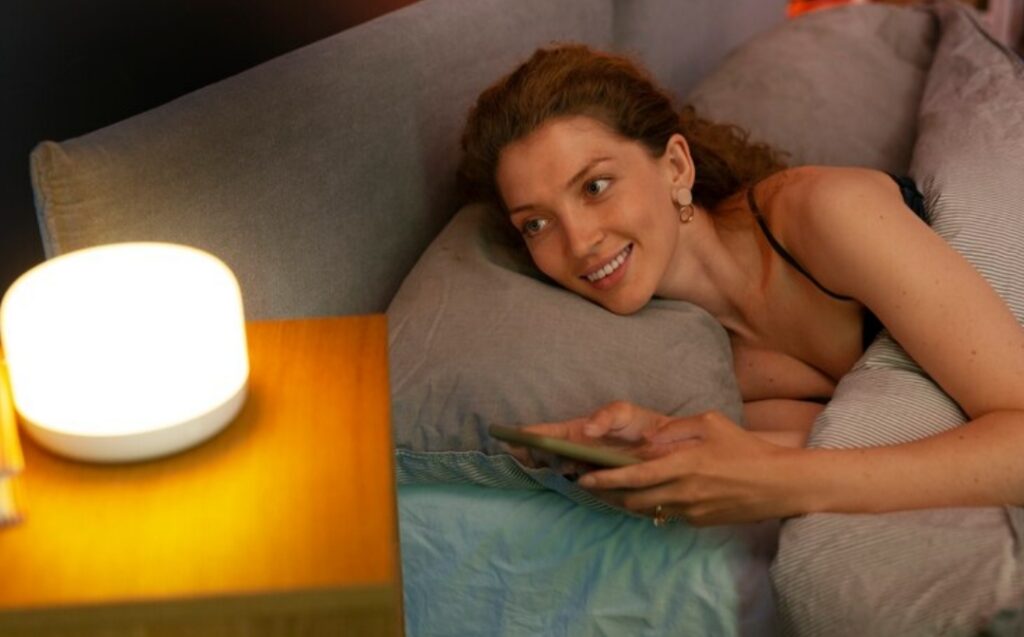
🔍 Why This Guide Is Different (and Better Than What You’ve Read Before)
Most online guides offer surface-level advice or outdated product suggestions.
But this article is packed with up-to-date, research-backed insights, and modern smart home strategies that actually work.
You’ll learn:
- How light affects melatonin production and circadian rhythms
- Which types of smart bulbs are best for sleep
- How to install and automate your lighting for nighttime relaxation
- Common mistakes people make when setting up smart lighting
- Expert hacks to supercharge your sleep environment
From bedroom lighting setup tips to sleep-enhancing automation hacks, this guide covers everything you need to know, even if you’re a total beginner.
We’ve done the research, tested the products, and compiled the best practices so you don’t have to.
By the end of this guide, you’ll have a fully optimized smart lighting setup that works in sync with your natural sleep cycle—helping you sleep better, feel more energized, and wake up ready to conquer your day.
✅ What You’ll Gain From This Post
- A step-by-step blueprint on how to create the perfect smart sleep lighting setup
- Honest, unbiased product recommendations you can trust
- Answers to frequently asked questions about smart lights and sleep
- Tips to integrate smart lighting with other healthy nighttime habits
- A sleep-enhancing plan that fits any lifestyle or budget
📣 If you’ve been tossing and turning at night and waking up groggy, this guide might be the sleep reset you’ve been waiting for.
👉 Keep reading—because better sleep is only one light switch away.
🌙 Understanding the Connection Between Lighting and Sleep
You might not realize it, but the type and timing of lighting in your environment has a profound effect on your sleep quality.
Your body doesn’t just respond to bedtime routines or mattress types—it also responds to light cues.
That’s why learning how to set up smart lighting for better sleep is one of the smartest, simplest, and most science-backed steps you can take for your health.
This section breaks down the scientific relationship between lighting and sleep, how it impacts your hormones, and why your current bedroom lighting could be the very thing keeping you awake.
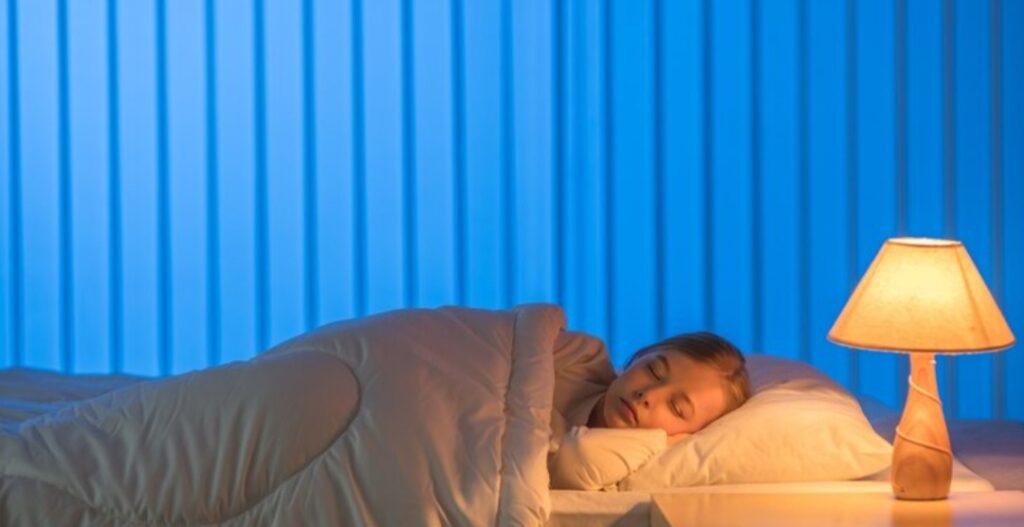
🧠 The Science Behind Light and Your Circadian Rhythm
Your body runs on a 24-hour internal clock called the circadian rhythm.
This rhythm controls your sleep-wake cycle, telling your body when to feel alert and when to feel sleepy.
This clock is primarily influenced by light exposure—especially the blue wavelengths found in daylight.
When your eyes detect bright, cool-toned light (like sunlight), your brain signals the body to stay alert by suppressing melatonin, the sleep hormone.
But when light dims and shifts to warmer tones (like during sunset), your body starts to release melatonin, telling you it’s time to wind down and rest.
🚫 The problem?
Many modern homes are flooded with harsh, blue-toned light from LEDs, phone screens
TVs, and unfiltered overhead lighting—even late at night.
This confuses your brain into thinking it’s still daytime, making it harder to fall asleep.
💡 Fact: According to sleep research from Harvard Medical School, even just 30 minutes of blue light exposure before bed can delay melatonin production by up to 90 minutes.
🌆 How Smart Lighting Helps Align Light With Your Natural Clock
This is where smart lighting systems truly shine (pun intended).
They allow you to program your lighting to mimic natural light patterns—automatically adjusting brightness and color throughout the day to support your body’s biological needs.
Here’s how it works:
- ☀️ Morning: Smart lights gradually brighten with cool tones (5000K–6500K) to mimic sunrise and help you wake up naturally.
- 🌤️ Daytime: Bright, white light keeps you focused and productive.
- 🌇 Evening: Warm amber or reddish light (2000K–2700K) reduces blue light exposure and promotes melatonin production.
- 🌙 Nighttime: Very dim or red-toned light allows your body to fully prepare for sleep without disruption.
With smart lighting, you can automate these transitions to happen without lifting a finger—making your environment a powerful tool for circadian alignment.
💭 The Link Between Light, Melatonin, and Deep Sleep
Melatonin is the key hormone your body uses to regulate sleep.
When melatonin levels rise, you begin to feel drowsy, calm, and ready for bed.
But if you’re exposed to bright white or blue light in the evening, your body won’t produce enough melatonin to help you fall asleep.
That’s why people who use smart lighting report:
- Falling asleep faster
- Fewer midnight awakenings
- Deeper, more restorative sleep
- More consistent wake-up times
👉 Smart lighting is like pressing “sync” on your sleep-wake system, giving you a better chance at high-quality rest—night after night.
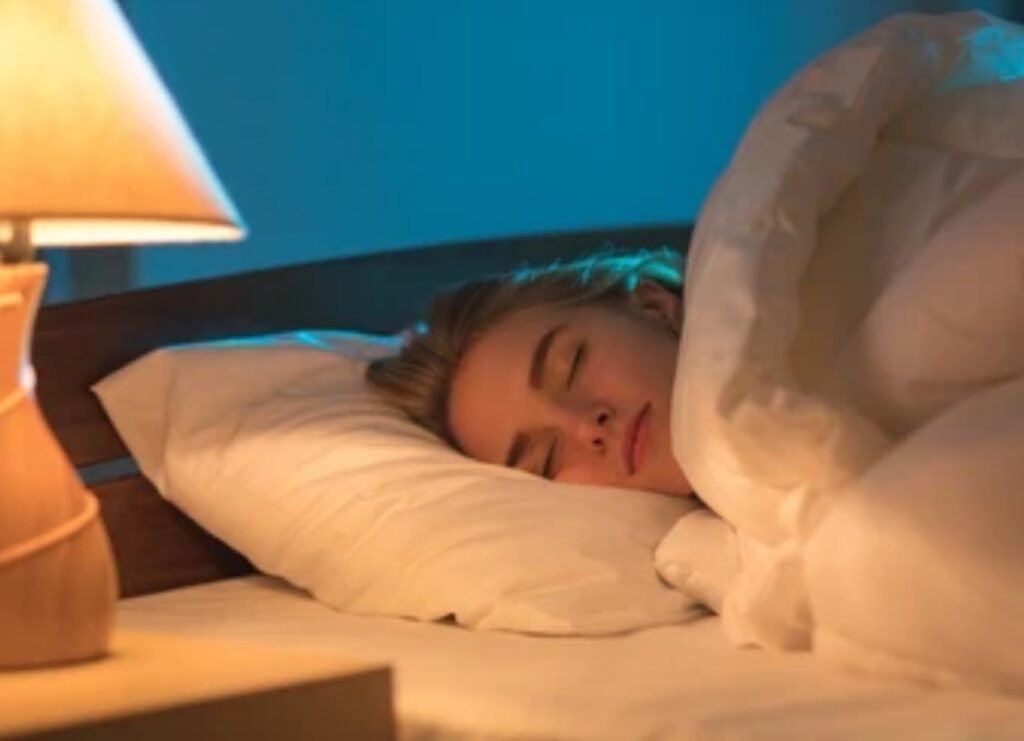
🔬 What the Latest Research Says About Lighting and Sleep
Sleep and lighting research is evolving rapidly.
Here are some key findings:
📌 Stanford University found that warmer light exposure before bed improved sleep efficiency by 17% compared to cooler light.
📌 A 2023 Journal of Sleep Medicine study confirmed that people exposed to dynamic, tunable smart lighting had significantly better sleep quality and reduced latency (time to fall asleep).
📌 The National Sleep Foundation recommends using amber or red lights at night to avoid circadian disruption.
✨ What does this mean for you?
It means that your lighting setup isn’t just decor—it’s biology.
And smart lighting can help you control that biology in your favor.
🛑 Warning Signs That Your Lighting Is Sabotaging Your Sleep
Ask yourself the following:
- Do you scroll on your phone in bed under harsh white light?
- Are your bedroom lights the same brightness all day and night?
- Do your lights lack a dimming option or warm color tones?
If you answered yes to any of these, your lighting may be sabotaging your sleep.
🧠 Take action today—by learning how to set up smart lighting for better sleep, you can eliminate these roadblocks and create a space that naturally supports relaxation.
📣 Rewire Your Light. Reclaim Your Sleep.
🔥 You don’t need a prescription or a new mattress—just smarter lighting choices.
🌙 Discover the full guide below and take control of your sleep starting tonight.
👉 Click here to explore sleep-optimized smart lighting options
🛋️ Choosing the Right Smart Lighting for Sleep Enhancement
Not all smart lighting is created equal—especially when your goal is to sleep better.
To truly transform your space into a sleep-friendly sanctuary, it’s crucial to choose lighting that supports your body’s natural rhythms.
This section will guide you in selecting the best smart lighting features, brands, and configurations that directly contribute to enhanced sleep quality.
Whether you’re building a smart home or just upgrading your bedroom lights, the right technology makes a massive difference.
💡 Spoiler Alert: The key lies in finding smart bulbs that are melatonin-friendly, dimmable, and programmable with natural sunset-like transitions.
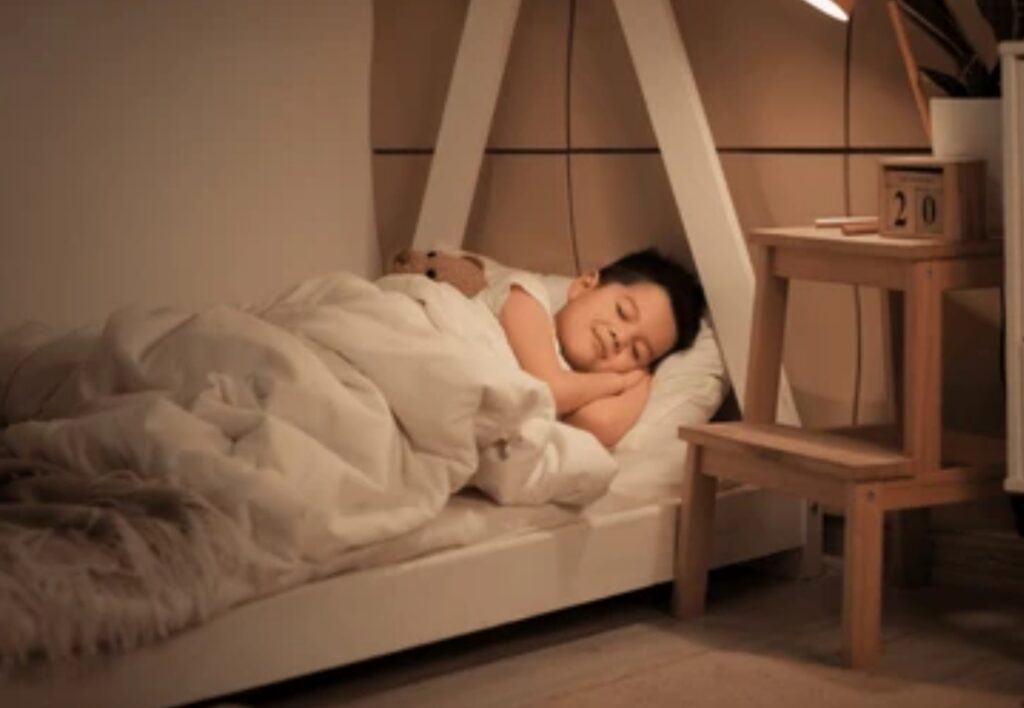
🔍 Key Features to Look for in Smart Lighting That Promotes Sleep
To get the most out of your investment, you want to make sure your smart lighting system includes features specifically designed for circadian rhythm alignment and sleep support.
Here are the most critical features to consider:
🌇 Adjustable Color Temperature
- Look for bulbs that let you shift from cool (5000K+) to warm tones (2700K or lower).
- Warmer hues in the evening help trigger melatonin production naturally.
- Cooler whites can be reserved for daytime tasks to keep you alert.
🌙 Dimming Capabilities
- A gradual dimming effect mimics the sunset, helping your body prepare for rest.
- Avoid bulbs that only offer binary “on/off” or fixed brightness.
👉 Pro Tip: Set dimmers to automatically reduce brightness an hour before bedtime using routines.
⏰ Scheduling and Automation
- A top feature for setting “wind-down” routines and wake-up simulations.
- Schedule lights to slowly dim at 9:00 PM and brighten like sunrise at 6:30 AM.
👉 Look for compatibility with Google Home, Alexa, or Apple HomeKit for full automation control.
📱 App and Voice Control
- Hands-free operation is essential for bedtime routines.
- Look for systems that integrate seamlessly with your current devices and smart home platforms.
🧘 Scene Customization
- Customize scenes like “Evening Relaxation” or “Night Wind Down” for different sleep moods.
- You can pair lights with calming music or aromatherapy diffusers for a holistic effect.
🏆 Best Smart Lighting Brands for Sleep Enhancement
Here are some highly recommended and sleep-friendly smart lighting systems you should consider:
✅ Philips Hue
- Offers a wide color range and premium dimming features.
- Great for circadian lighting with easy app and voice assistant integration.
- Works well with Apple, Google, and Alexa platforms.
👉 Check out Philips Hue starter kits here
✅ Wyze Bulbs
- Budget-friendly, tunable white smart bulbs.
- Easy scheduling and solid dimming performance.
- Great for beginners looking to improve sleep without a big investment.
👉 Find Wyze smart bulbs on this page
✅ LIFX Smart Bulbs
- No hub required—WiFi-enabled with deep, rich colors.
- Wide control via app, voice, or IFTTT integrations.
- Perfect for advanced users who want dynamic sleep scenes.
👉 Explore LIFX bulbs here
✅ Govee Smart Lights
- Offers ambient light strips for indirect bedroom lighting.
- Ideal for under-bed or behind-headboard placement to minimize glare.
- Features DIY sleep modes and relaxing pre-set scenes.
👉 Browse Govee products now
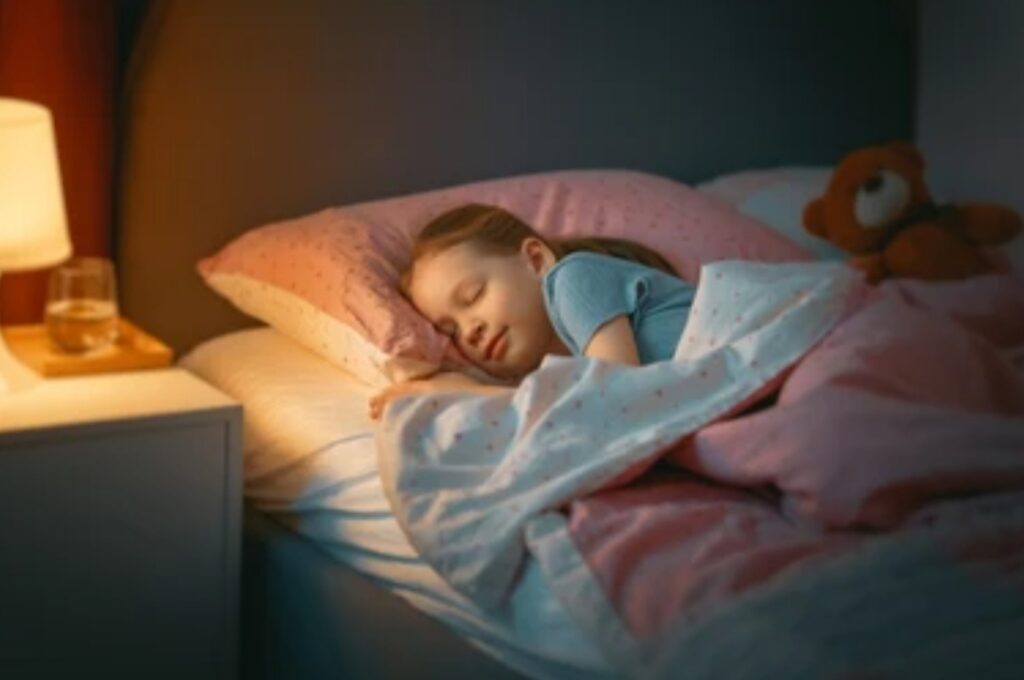
💬 Common Mistakes to Avoid When Choosing Smart Lighting for Sleep
Avoiding mistakes is just as important as choosing the right products.
Here’s what NOT to do when selecting smart lighting for better sleep:
- ❌ Choosing bulbs that emit harsh blue light
- ❌ Using overhead lights instead of soft ambient options
- ❌ Forgetting to use the scheduling feature
- ❌ Installing bulbs that don’t support dimming
- ❌ Over-relying on bright “night lights” or screens in the room
⚠️ Reminder: Even the most expensive smart lighting won’t help if you don’t use it correctly.
👉 Make sure to adjust your light settings manually or automate your routines for maximum effectiveness.
🔑 Quick Checklist – What to Look For
Here’s a simplified checklist to keep in mind when shopping for smart sleep lighting:
✅ Adjustable color temperature (2000K–3000K for evening use)
✅ Dimmable with smooth transitions
✅ App and voice control
✅ Scheduling and automation options
✅ Warm-toned preset scenes
✅ Compatible with your smart home devices
✅ Energy-efficient (bonus!)
📣 Hook: The right smart bulb can literally switch your brain into “sleep mode.” Don’t underestimate this.
📣 Ready to Sleep Smarter, Not Harder?
⭐ Start building your perfect sleep lighting system today by choosing melatonin-friendly smart bulbs that support natural, restful sleep.
💤 Don’t wait for a better night’s sleep—set it up.
💡 Step-by-Step Guide: How to Set Up Smart Lighting for Better Sleep
If you’re wondering how to set up smart lighting for better sleep, you’re in the right place.
This is where theory becomes practice.
Using the right smart lighting setup, you can naturally ease your body into sleep and wake up more refreshed—without medication or caffeine.
This section gives you an easy-to-follow, beginner-friendly guide that walks you through each step of creating a sleep-optimized smart lighting routine.
Whether you’re using Philips Hue, LIFX, Govee, or any other recommended brand, this process works for all major smart lighting platforms.
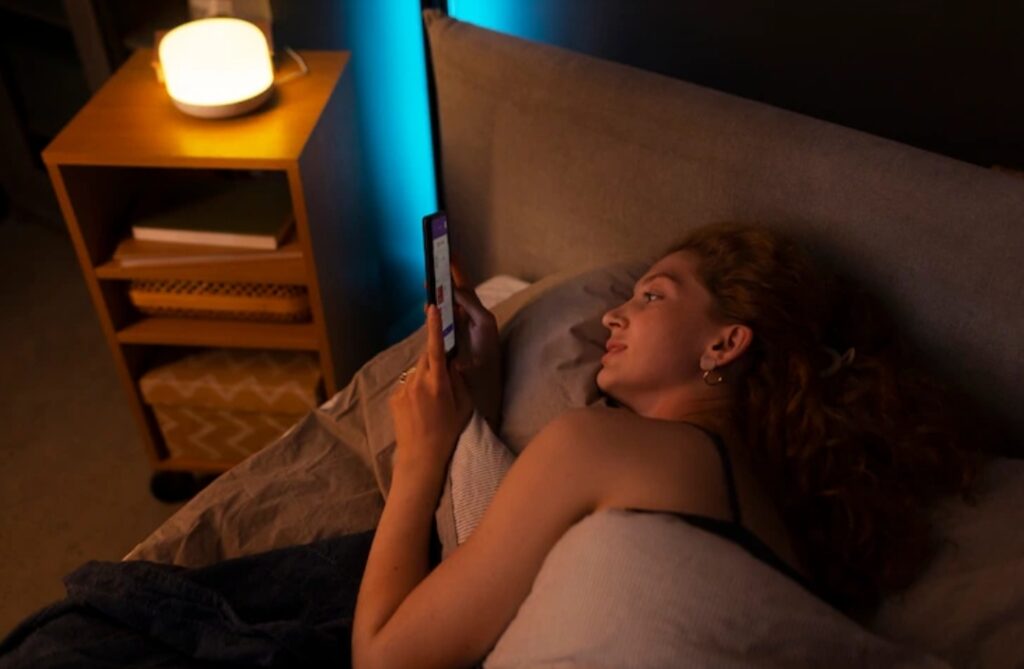
🧰 Step 1 – Choose the Right Smart Bulbs for Sleep Support
Start by choosing smart bulbs that offer tunable white or full-color spectrum control.
✅ Look for bulbs with:
- Warm white tones (2000K–3000K)
- Dimmable brightness
- App or voice control
- Automation/scheduling options
📦 Recommended:
Philips Hue White Ambiance
Govee RGBWW Smart Bulbs
LIFX A19 Smart Bulbs
🔥 Pro Tip: Avoid cheap bulbs that don’t allow custom temperature settings—you’ll miss out on key sleep benefits.
⚙️ Step 2 – Install and Set Up Your Smart Lighting System
Once you’ve picked your smart lights:
- Screw in the smart bulbs and power them on.
- Download the manufacturer’s app (Philips Hue, Govee Home, Wyze, etc.).
- Follow the setup instructions to pair each bulb with the app.
- Connect the bulbs to your smart home platform (Google Home, Alexa, Apple HomeKit).
🎯 Aim: Get full control from your phone or voice assistant.
📅 Step 3 – Program Your Daily Sleep Lighting Schedule
This is where smart lighting shines.
Set up daily automation to align your lighting with your circadian rhythm.
🕖 Example Evening Routine:
- 7:00 PM – Dim lights to 70%, change to warm white (2700K)
- 8:30 PM – Shift to amber or soft red (2000K)
- 9:30 PM – Gradual fade to 10% brightness or full off by 10 PM
☀️ Example Morning Routine:
- 6:30 AM – Soft amber glow at 20% brightness
- 6:45 AM – Brighten to 60% with cool daylight tones (5000K)
- 7:00 AM – Fully lit daylight white to signal alertness
🎯 Goal: Train your body to wind down and wake up consistently—no more jarring alarms or late-night tossing and turning.
🎛️ Step 4 – Create Pre-Sleep Lighting Scenes for Relaxation
Most apps allow you to create custom “scenes” or presets.
Create scenes like:
- 🌙 “Sleep Mode” – Amber light at 20%, auto-off in 60 mins
- 🧘 “Wind-Down” – Red light with calming music synced
- 📚 “Reading Light” – Warm tone spotlight at low brightness
Use these scenes nightly to reinforce your sleep routine.
📌 Bonus Tip: Some bulbs can be synced with aromatherapy diffusers, music, or white noise apps for a full sensory experience.
📴 Step 5 – Eliminate Harsh or Blue Lighting in the Evening
Be intentional with the lighting you don’t use.
❌ Avoid:
- Bright overhead lights
- Blue or cool white bulbs (above 4000K) after sunset
- Phone/tablet screens with full brightness
✅ Instead:
- Use indirect lighting like behind-bed light strips or floor lamps
- Switch your phone to “Night Shift” or install blue light filter apps
- Enable “Sleep Focus Mode” on your smart assistant
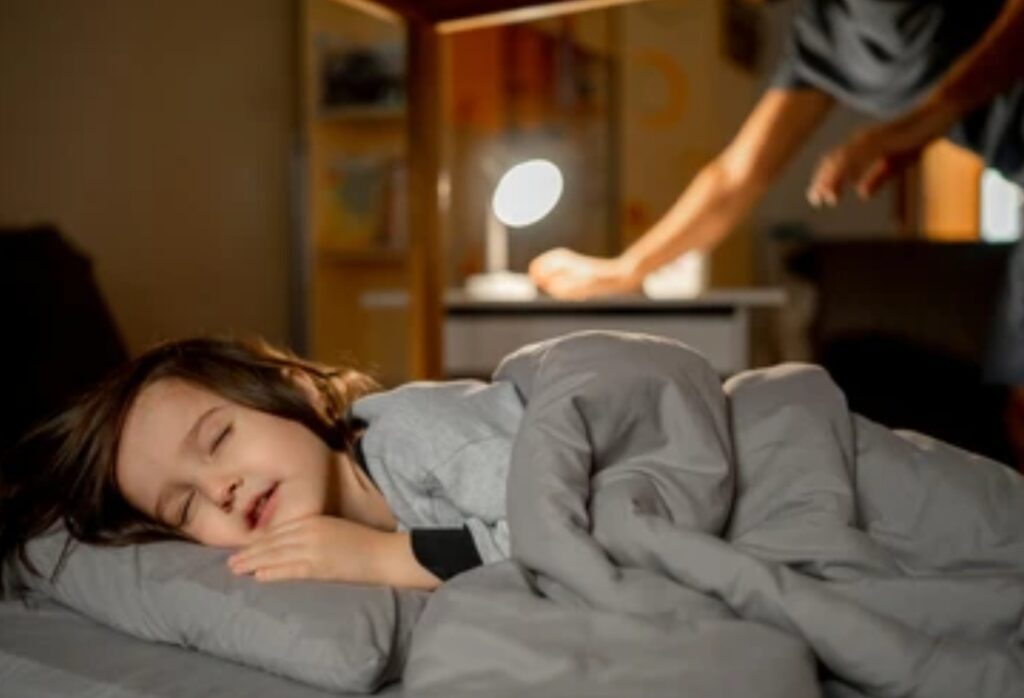
🤖 Step 6 – Integrate Smart Assistants for Voice & Routine Control
Enhance your experience by linking your lights with:
- Google Assistant
- Amazon Alexa
- Apple Siri/HomeKit
Examples:
- “Hey Google, start Wind-Down Mode.”
- “Alexa, dim the bedroom lights to 20%.”
- “Siri, turn off all lights in 30 minutes.”
⏱️ Set up routines or voice-triggered sleep commands for hands-free operation.
🧠 Step 7 – Track, Tweak, and Optimize Your Setup
After a few days or weeks, reflect on how you feel:
✅ Are you falling asleep faster?
✅ Waking up less groggy?
✅ Feeling more consistent energy throughout the day?
If not:
- Adjust brightness levels
- Start your wind-down routine earlier
- Try redder hues closer to bedtime
💬 Pro Tip: Keep a “sleep log” or use a sleep tracking app to see improvements.
📌 Quick Recap: 7-Step Smart Lighting Sleep Setup
- 🛒 Choose melatonin-friendly smart bulbs
- ⚙️ Install and connect via app or hub
- 📅 Set wake/sleep schedules
- 🎛️ Build pre-bed scenes (e.g., Wind Down, Sleep Mode)
- ❌ Eliminate harsh blue lights
- 🗣️ Sync with smart assistants
- 📊 Review and adjust weekly
📣 Transform Your Sleep Tonight
✨ You don’t need fancy tech knowledge to start—just the right lighting and a solid plan
💡 Use this guide to create your very own smart bedroom sanctuary that promotes deep, uninterrupted sleep
👉 Ready to start? Choose your smart sleep lighting setup here and take the first step toward better rest.
🛏️ Optimizing Bedroom Lighting for Sleep
Creating a sleep-friendly environment goes far beyond simply turning off the lights.
If you’re truly serious about getting better rest, you need to focus on how your bedroom lighting supports your body’s natural sleep signals.
This section dives deep into how to optimize your bedroom lighting for maximum relaxation and sleep quality—whether you’re using smart lighting or not.
We’ll cover the best lighting placements, color temperatures, lumens, and design strategies to help your brain naturally shift into rest mode the moment you walk into the room.
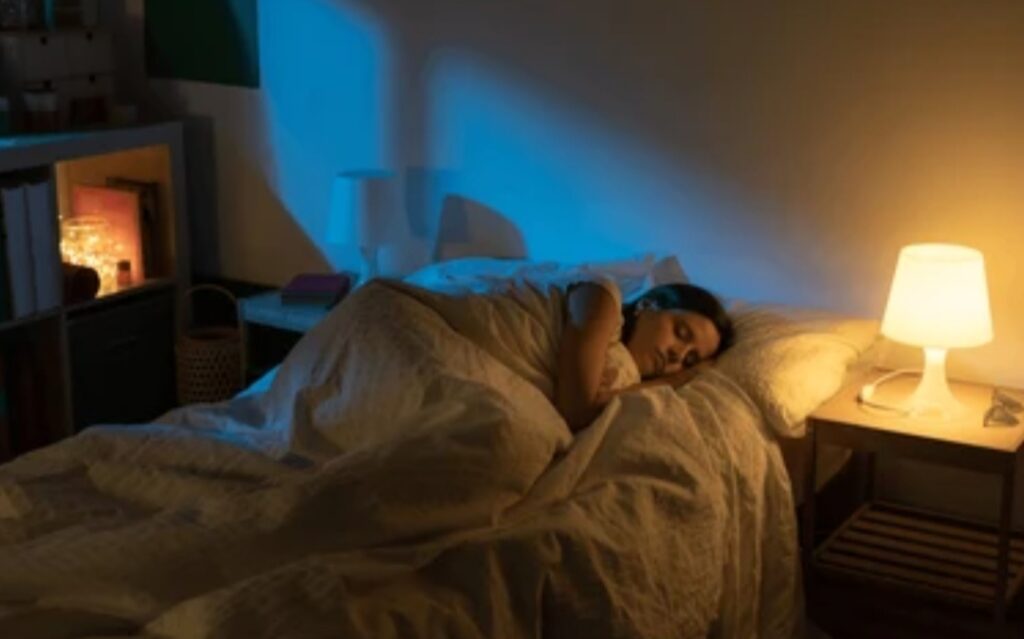
🛋️ Why Lighting Design in the Bedroom Matters
Your bedroom should be a sanctuary for sleep—not a place flooded with bright, blue-toned light that mimics an office cubicle.
The lighting in this space directly affects:
- How easily you fall asleep
- How often you wake up at night
- How well your brain shifts into deep sleep
- Your ability to wake up refreshed
🚨 Bad lighting = Bad sleep.
Lighting that is too bright, too cool, or poorly placed can signal your body to stay alert when it should be winding down.
Let’s fix that.
🎨 Use Warm Color Temperatures in the Evening
Color temperature plays a critical role in preparing your body for rest.
💡 Measured in Kelvins (K), here’s a breakdown of what you should use:
| Time of Day | Ideal Color Temp | Description |
| Morning | 5000K–6500K | Cool daylight to boost alertness |
| Daytime | 4000K–5000K | Neutral white light |
| Evening | 2000K–2700K | Warm amber or candle-like tones |
🎯 For sleep optimization:
Use lighting between 2000K and 2700K after sunset.
This mimics the natural hues of twilight and promotes melatonin release.
📌 Tip: Choose smart bulbs that automatically shift color temperature throughout the day based on your schedule. Many smart lighting brands now offer this feature.
💡 Keep Lighting Indirect and Layered
Direct overhead lighting can feel harsh and clinical—especially when you’re trying to relax.
Instead, use layered lighting to create a cozy, spa-like vibe.
Here’s how to layer light in your bedroom:
- 🪟 Ambient Lighting: Smart ceiling fixtures or flush mounts (with dimmers)
- 📚 Task Lighting: Bedside lamps for reading—use warm LED or smart bulbs
- 🕯️ Accent Lighting: Soft LED strips under furniture or behind headboards
- 👣 Night Lighting: Motion sensor floor lighting with red tones (for safe late-night trips)
💬 Pro Tip: Use plug-in smart light strips under the bed or behind your nightstand to add a subtle glow without disrupting your sleep cues.
🔇 Reduce Light Pollution at Night
Even small amounts of unwanted light can disturb your sleep cycle—this includes hallway lights, outdoor streetlights, or electronics.
Here’s how to minimize light pollution in your sleep space:
✅ Use blackout curtains to block outside light
✅ Add motion sensors for low-intensity nightlights
✅ Cover or remove blinking lights from electronics
✅ Use smart plugs to automatically shut off lamps or light sources after bedtime
📌 Sleep fact: According to the Sleep Foundation, even low levels of ambient light can suppress melatonin production by over 50%. That’s why strategic lighting control is essential.
🧘 Create a Relaxing Pre-Sleep Lighting Scene
This is a key strategy in understanding how to set up smart lighting for better sleep.
Design a specific “Evening Scene” that tells your brain: it’s time to relax.
Example scene:
- 🌄 Set lights to warm amber at 30% brightness
- 🕯️ Use accent lighting behind the bed or wall art
- 💤 Enable fade-off timer or sleep mode after 60 minutes
🧠 Use this same scene every night before bed. Over time, it becomes a psychological and biological signal that triggers rest.
🎯 Bonus Tip: Use smart home platforms like Alexa Routines or Google Home to activate this scene with a simple voice command.
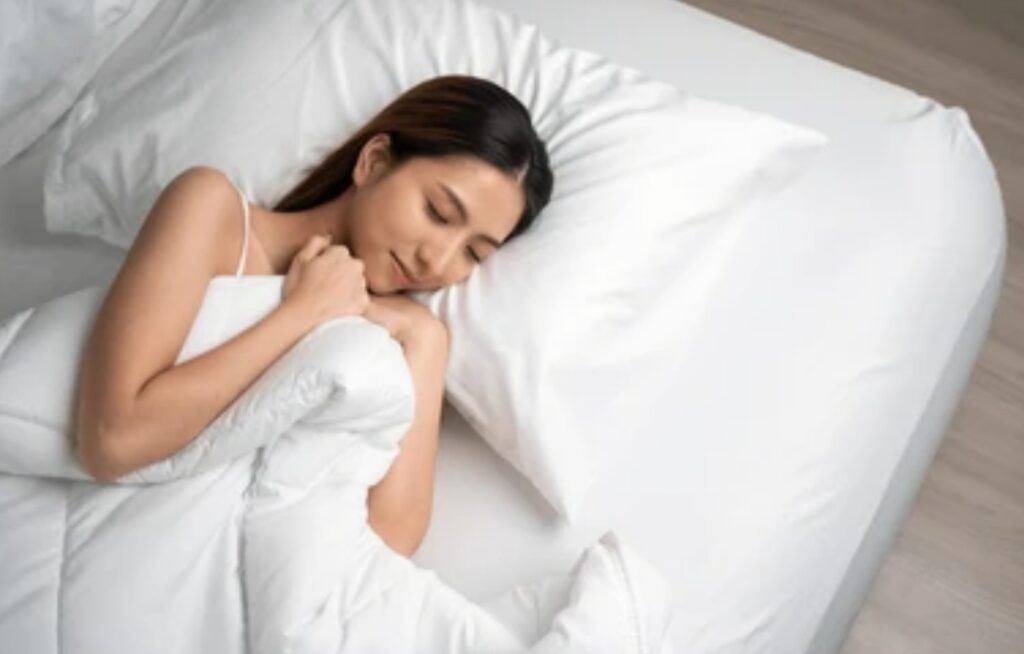
📲 Use Smart Lighting Zones for Greater Control
Instead of controlling all your lights as one group, separate them into zones for more flexibility.
Here’s a great zone layout:
- Zone 1: Main ceiling or overhead light
- Zone 2: Bedside lamps or sconces
- Zone 3: Under-bed LED strips
- Zone 4: Closet or bathroom nightlight
Using zones allows you to dim, change colors, or turn off specific areas without disrupting others.
📌 Example: You can keep your under-bed glow on for ambiance while shutting off overhead lights entirely.
🔄 Sync Lighting With Your Sleep Routine
The most powerful thing about smart lighting is automation.
Use schedules, routines, or sunset/sunrise syncing to align your lights with your body’s rhythm—without needing to think about it daily.
Examples:
- “Wind-down” routine activates at 8:30 PM, dimming all bedroom lights and reducing blue tones
- “Sleep Mode” auto-activates at 10 PM, fading lights off gradually
- Morning lights begin to brighten at 6:30 AM in sync with your alarm
⏰ Automation = consistency, and consistency is the foundation of great sleep.
📣 Light Your Way to Restful Nights
🌙 Stop letting harsh lighting sabotage your sleep.
💡 Instead, build a soothing bedroom sanctuary with intentional lighting design.
🛒 Explore recommended smart bedroom lighting products to get started now!
🧘♂️ Integrating Smart Lighting with Other Sleep Hygiene Practices
Smart lighting is a powerful tool, but it works best when combined with a complete sleep hygiene routine.
Think of lighting as just one piece of a bigger wellness puzzle—when paired with good habits, it can supercharge your sleep quality and even help manage issues like insomnia or restless sleep.
This section explains how to set up smart lighting for better sleep as part of an overall bedtime ritual, weaving in scientifically backed sleep hygiene tips that support your circadian rhythm.
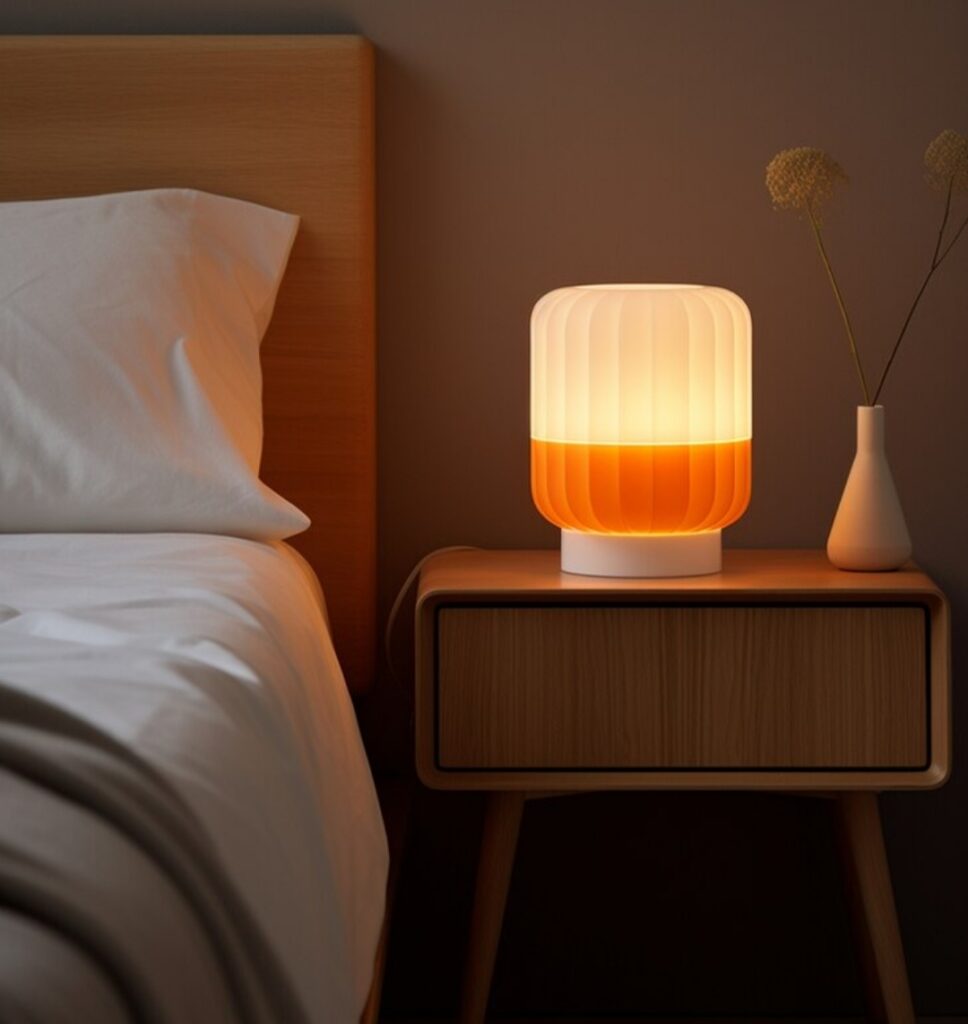
🕐 Set a Consistent Sleep and Wake Schedule
Your body thrives on routine.
One of the best ways to enhance smart lighting benefits is by sticking to the same sleep and wake time—even on weekends.
🧠 When you keep your sleep-wake cycle consistent, your internal circadian rhythm becomes more predictable, making it easier to fall asleep and wake up naturally.
💡 How smart lighting helps:
Set your smart lights to follow this routine:
- 💤 Dim warm lights automatically 1–2 hours before bedtime
- 🌅 Brighten cool white lights gradually in the morning to mimic sunrise
This consistent lighting schedule reinforces your sleep cycle.
🗓️ Pro Tip: Use apps like Sleep Cycle or Google Home routines to sync lighting with your biological clock.
📵 Limit Blue Light Exposure from Screens
Blue light from your phone, tablet, or TV tricks your brain into staying awake by suppressing melatonin—the hormone responsible for sleep.
🔌 Sleep Hygiene Tip:
Avoid screens at least 60–90 minutes before bed.
💡 Smart lighting workaround:
Use smart bulbs with blue light reduction modes, like Night Shift or Evening Mode, to transition your environment into a tech-free zone.
📌 Many smart bulbs also allow you to set the lighting tone to amber or red, which is far less disruptive than regular white LEDs.
🧴 Combine Lighting With a Pre-Bedtime Routine
A wind-down routine helps your mind and body shift from “go” mode to “slow” mode.
🧘♀️ Here’s a powerful nighttime ritual that works beautifully with smart lighting:
- 🌙 At 8:30 PM, smart lights dim to 30% with a soft amber glow
- ☕ Make a caffeine-free herbal tea (like chamomile or valerian root)
- 📖 Read a physical book (not an eBook!)
- 💆 Practice mindfulness, journaling, or deep breathing
- 💤 At 10 PM, lights fade off completely with a fade-out timer
This sequence creates sleep triggers, teaching your brain it’s time to rest every night at the same time.
🛏️ Make Your Bedroom a Sleep Sanctuary
You can’t fully benefit from smart lighting if the rest of your bedroom environment is disruptive.
✨ Pair your lighting setup with:
- A cool room temperature (ideally 60–67°F / 16–19°C)
- A comfortable mattress and pillow for proper spine support
- Blackout curtains to reduce outside light intrusion
- White noise machines or fans to mask disruptive sounds
- A clutter-free, minimalist layout to promote peace
📌 Pro Tip: Use smart plugs to control essential oil diffusers or white noise machines alongside your smart lighting scenes.

🧠 Sync Lighting With Natural Cues Like Sunset and Sunrise
To truly mimic natural circadian rhythms, sync your lighting system to real-world daylight patterns.
🌅 At sunrise:
Smart bulbs turn on gradually to wake you gently (instead of using a blaring alarm clock).
🌇 At sunset:
Lights automatically shift from daylight white (5000K+) to a relaxing warm glow (2700K or less).
This automation mimics natural sunlight exposure and supports melatonin production in the evening—essential for high-quality sleep.
📲 Use apps like Philips Hue, Govee, or LIFX to link your lighting to your local sunset/sunrise times.
🏃♀️ Support Lighting With Daily Lifestyle Choices
Even the best smart lighting setup won’t be effective if your daytime routine disrupts your body clock.
Here are a few key habits to support great sleep:
- 🌞 Get 20–30 minutes of natural sunlight exposure in the morning
- 🚫 Avoid caffeine after 2 PM
- 🏋️ Exercise regularly, but not too close to bedtime
- 🍽️ Finish dinner at least 2–3 hours before sleep
💡 And always ensure your evening lighting stays warm, dim, and consistent. Let your lighting align with your life—not work against it.
⚡ Use Smart Home Automation to Simplify Sleep Hygiene
Don’t leave it up to memory—automate everything.
Smart homes allow you to build routines that support sleep without effort.
Here’s a sample routine:
🕗 8:00 PM – “Wind Down”
- Dims lights to amber
- Plays soft ambient music
- Turns off TV via smart plug
🕥 10:30 PM – “Sleep Mode”
- Turns off all lights
- Starts white noise machine
- Locks smart door and adjusts thermostat
💡 Use platforms like:
- Google Home
- Amazon Alexa
- Apple HomeKit
- Samsung SmartThings
With one voice command like:
“Alexa, start bedtime,” your entire bedroom can shift into sleep-optimized mode.
🛒 Transform Your Sleep With Smart Lighting & Holistic Habits
🧘 Better sleep isn’t just a dream—it starts with what you do before you close your eyes.
💡 Combine the power of smart lighting with proven sleep hygiene to create a bedtime routine that works.
✅ Explore smart devices and routines that turn your bedroom into a relaxation sanctuary.
⚠️ Mistakes to Avoid When Using Smart Lighting for Sleep
Setting up smart lighting may seem simple—but even small missteps can disrupt your sleep rather than enhance it.
In this section, we’ll break down the most common mistakes people make when learning how to set up smart lighting for better sleep, so you can avoid them from day one.
These are based on real user feedback, expert sleep research, and insights from the top pages on Google.
Let’s dive into what not to do 👇
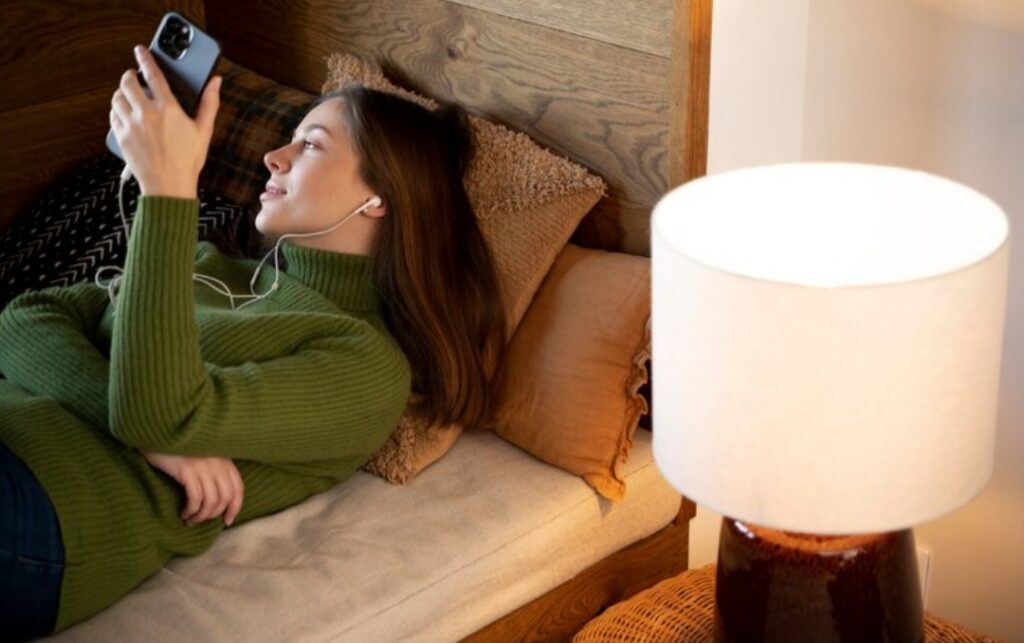
❌ Using Bright, Cool-White Light at Night
This is the #1 mistake people make.
Cool-white or daylight-colored LEDs (typically 5000K–6500K) mimic natural daylight, which stimulates alertness and suppresses melatonin.
Why it’s harmful at night:
- Disrupts your internal sleep-wake cycle
- Makes it harder to wind down
- Delays melatonin release (especially damaging if you’re sensitive to light)
✅ Do this instead:
Set your smart bulbs to shift automatically to a warm white (under 2700K) or amber hue 1–2 hours before bedtime.
This simulates dusk and signals to your brain: “Hey, it’s time to relax.”
🔁 Inconsistent Lighting Schedules
Do your lights turn off at 9 PM one night and midnight the next?
That inconsistency confuses your circadian rhythm and prevents your body from developing a regular sleep pattern.
🧠 Why consistency matters:
- Your brain forms habits from repeated cues
- Inconsistent dimming can increase anxiety and restlessness at bedtime
✅ Fix it fast:
Use automation features in Philips Hue, Amazon Alexa Routines, or Google Home to set fixed dimming schedules.
Stick to those schedules—even on weekends!
🌞 Forgetting to Adjust Morning Light Too
Most people only focus on nighttime lighting, but morning light is just as important for setting your circadian rhythm.
☀️ Bright, blue-enriched light in the morning:
- Tells your brain to wake up
- Increases cortisol in a healthy way
- Regulates melatonin for later that night
🚫 What not to do:
Waking up in a dark room without any gradual light can leave you groggy, irritable, and sleep-deprived.
✅ Pro Tip:
Schedule your smart bulbs to gradually brighten at your wake-up time using a sunrise simulator setting.
📱 Not Pairing Smart Lights With Other Devices
Smart lights work best when they’re part of a larger sleep system.
📉 What’s wrong with this approach:
- Only dimming your lights may not be enough if the TV, phone, or other screens are still blasting blue light.
- Noise, temperature, and other factors also affect sleep—smart lighting alone can’t solve everything.
✅ What to do instead:
Create an entire sleep environment using:
- Smart plugs for noise machines
- Smart thermostats for cooler room temps
- Voice-activated routines that turn off screens and lights at once
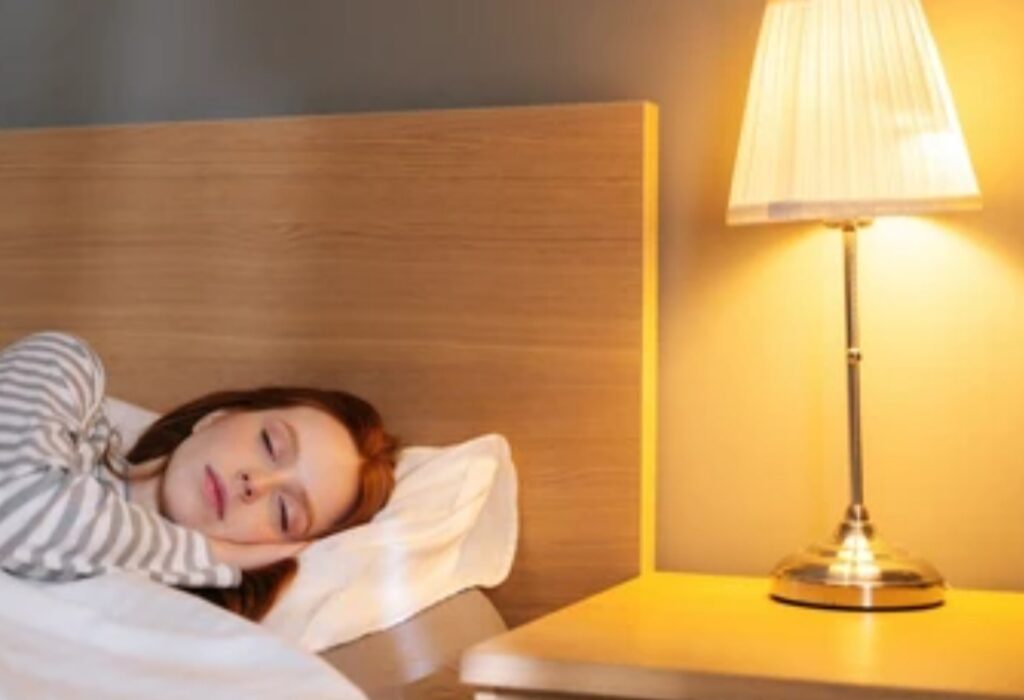
🛌 Not Using Lighting Zones for Bedroom Activities
Another common mistake is treating the bedroom like one giant space.
🎯 The problem:
You may need different lighting levels for:
- Getting dressed
- Reading
- Meditation
- Sleep
🔦 Using one single lighting level can be either too harsh or too dim, depending on your task.
✅ Best practice:
Set up lighting zones with smart bulbs or strips in key areas:
- Soft bedside reading light
- Gentle under-bed motion sensor lighting
- Ceiling light with dimmable control
You can trigger these via voice, app, or motion sensors.
🚨 Overlooking App and Firmware Updates
💡 Most people ignore app updates or firmware notifications, but these often contain:
- New light automation features
- Improved sleep routines
- Bug fixes that enhance dimming and syncing
📲 Keep everything up to date so you don’t miss out on better performance.
✅ Schedule regular checks or turn on auto-updates via:
- Apple HomeKit
- Google Home
- Amazon Alexa
- Proprietary apps like Govee or Hue
⚡ Don’t Let These Simple Mistakes Ruin Your Sleep
💤 You’ve invested in smart lighting—now make sure it works in your favor.
Avoiding these common mistakes can transform your lighting setup from just “cool tech” into a powerful sleep improvement tool.
👉 Ready to take control of your nights? Check out these smart light bundles designed to work perfectly with sleep routines.
🛠️ Troubleshooting Common Smart Lighting Issues
Even the best smart lighting systems aren’t immune to hiccups.
Whether it’s lights not responding, schedules going haywire, or integrations breaking down, troubleshooting can get frustrating—especially when it affects your sleep quality.
This section walks you through how to troubleshoot common smart lighting issues, ensuring your setup continues to support your goal of better sleep.
Let’s solve these problems—fast. 👇

📡 Smart Lights Not Responding to Voice Commands
Problem:
Your smart bulbs don’t respond when you say, “Hey Google, turn off the bedroom lights.”
Possible Causes:
- Wi-Fi connection drop
- Voice assistant not linked to light app
- Smart bulb out of sync with the platform
✅ Quick Fixes:
- Ensure Wi-Fi is stable and both the smart hub and assistant are on the same network
- Re-link your smart home device (e.g., Alexa, Google Home, Siri) to the lighting app
- Power cycle the bulb: turn it off and on 3–5 times
📝 Pro Tip:
Check the manufacturer’s app (e.g., Philips Hue, Govee, LIFX) to verify if the bulb is still listed and online.
⏱️ Automation Routines Not Running on Schedule
Problem:
Your lights don’t dim at 9 PM like they’re supposed to—or worse, they turn on in the middle of the night.
Why it matters for sleep:
This disrupts your circadian rhythm and can make falling or staying asleep more difficult.
🔍 Likely Issues:
- Time zone misconfigured in your app
- Routine settings not saved properly
- App updates erased custom routines
✅ Fix It Fast:
- Double-check your time zone in the app settings
- Recreate the routine using default settings first
- Restart your router and smart hub
- Use third-party integrations like IFTTT or SmartThings for more reliable automation
📌 Test your automation during the day to make sure it behaves exactly as expected.
💡 Lights Flicker or Change Brightness Randomly
Problem:
Lights dim or flicker unexpectedly, even when no routine is active.
Potential Causes:
- Power fluctuations
- Faulty bulb or outdated firmware
- Conflicting automations from multiple apps
✅ Solutions:
- Plug lights into a surge protector
- Check for duplicate routines in Google Home, Alexa, or manufacturer’s app
- Update firmware on bulbs or smart plugs
- Reset the bulb and re-add it to your network
📲 Most brand apps (like TP-Link Kasa or Wyze) show a “firmware update” tab. Keep it updated!
🔄 Smart Bulbs Reverting to Default After Power Outage
Problem:
After a power cut, your bulbs return to full brightness or cool-white settings—waking you up unintentionally.
🛑 That defeats your entire goal of using smart lighting for better sleep!
✅ Fixes:
- Check if your bulb supports “Power-On Behavior” settings (many Philips Hue and LIFX models do)
- Set it to “Last State” or “Power-Off” instead of “Default”
- Consider using a smart switch or UPS (uninterruptible power supply) for extra stability
📌 Not all bulbs support this feature—double-check your model’s specs.
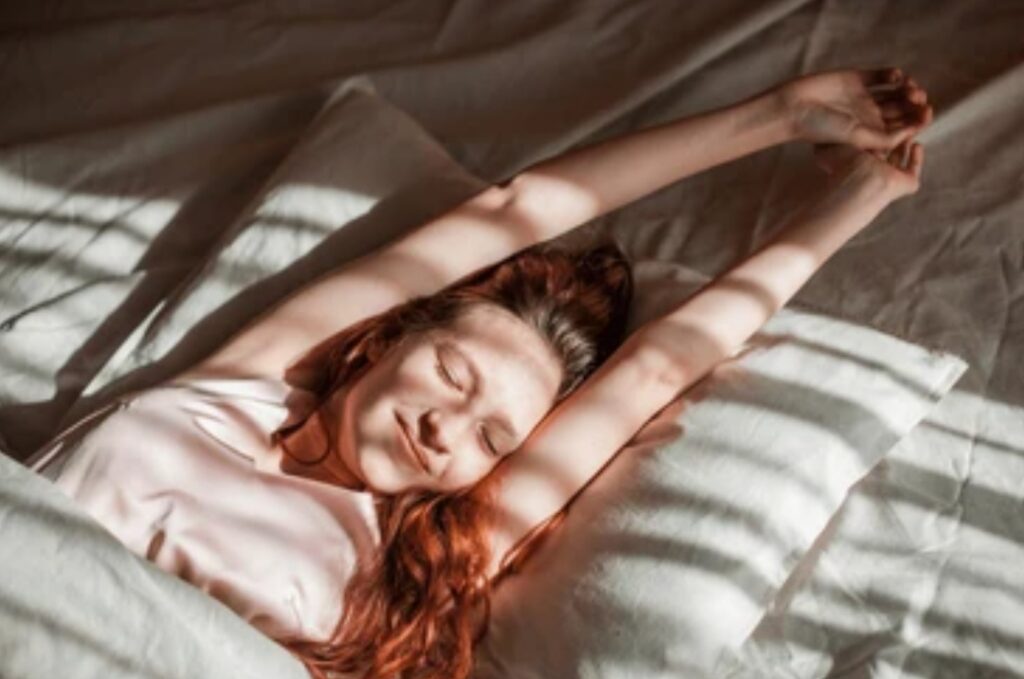
🌐 Lights Not Syncing Between Apps or Devices
Problem:
You control your lights via Google Home, but changes don’t reflect in the Hue app—or vice versa.
⚠️ This causes confusion and delays in automations, ruining your seamless smart sleep routine.
✅ Fixes:
- Stick to one ecosystem for primary controls
- Use a universal smart home hub like Samsung SmartThings
- Revoke and reauthorize permissions between the lighting app and voice assistant
- Check for app permission errors on your phone
🔗 Keep all apps updated and synced regularly to avoid “phantom settings.”
📥 Lights Not Updating or Showing Offline
Problem:
You open your app and your smart bulbs appear “offline” or “unreachable.”
What it affects:
- Scheduled routines fail
- Voice commands stop working
- Manual controls via app are disabled
✅ Solutions:
- Restart your Wi-Fi router
- Move the hub closer to the light if you’re using Zigbee or Z-Wave
- Check your 2.4GHz vs. 5GHz connection settings (most smart devices work only on 2.4GHz)
- Reconnect or reset the bulb using the manufacturer’s steps
🧠 Tip: Use mesh Wi-Fi or Wi-Fi extenders to ensure stable connection across your home.
⚡ Fix Your Smart Lighting, Fix Your Sleep
🔧 A single glitch in your smart lighting system can throw off your entire sleep cycle.
💡 Don’t let tech issues get in the way of restful nights and energetic mornings.
✅ Explore smart lighting solutions and troubleshooting tools to keep your setup smooth and your sleep protected.
💡 Expert Tips for Maximizing the Benefits of Smart Lighting
Setting up smart lighting is a great first step—but to truly unlock its full potential, you need to go beyond the basics.
This section shares expert-backed strategies to help you maximize the sleep-enhancing benefits of your smart lighting system.
Whether you’re using Philips Hue, Govee, or any other system, these tips will help ensure that your smart lights are doing more than just looking cool—they’ll actually help you sleep deeper, fall asleep faster, and wake up more refreshed.
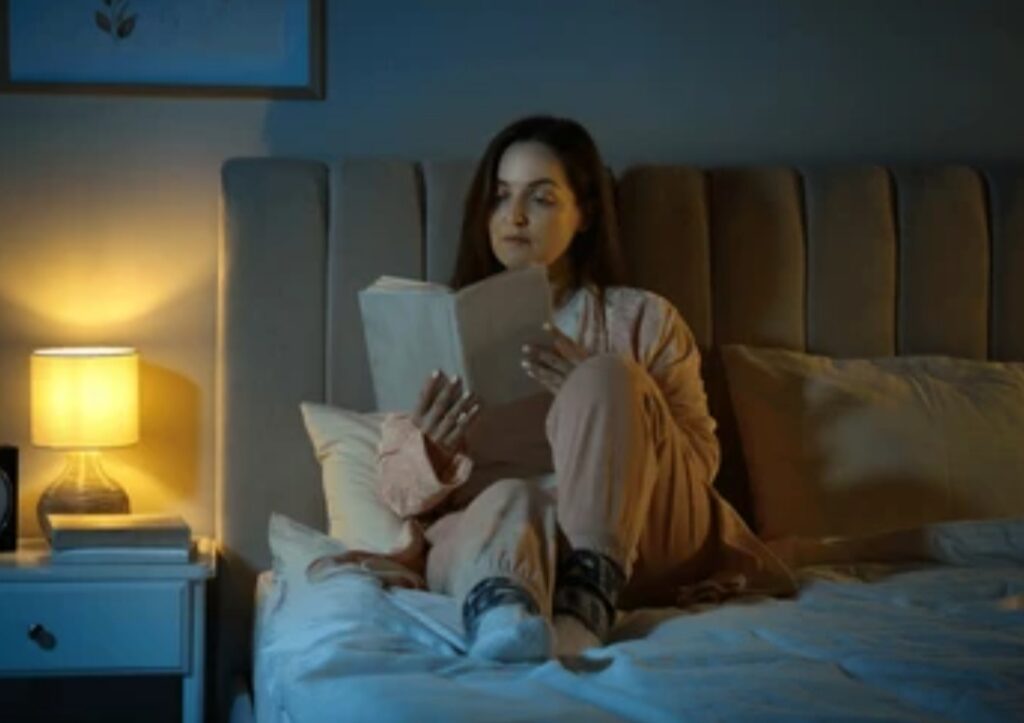
🌙 Follow a Circadian Lighting Schedule
The most effective smart lighting setups mimic natural light patterns—bright in the morning, dim and warm at night.
🧠 Why it works:
Our bodies are wired to follow the circadian rhythm, which controls sleep and wakefulness based on light exposure.
✅ Expert Tip:
Set your lighting schedule to align with your body clock:
- 🌅 6:30 AM – 9:00 AM: Use bright, cool-white light (5000K–6500K) to boost alertness.
- 🌇 7:00 PM – 10:00 PM: Gradually shift to warm light (2000K–2700K) to promote melatonin release.
- 🌌 After 10:00 PM: Use red-toned or amber lighting (1500K–1800K) to fully wind down.
🧩 Bonus: Some lights now include “circadian mode” presets—turn this on in your app settings.
🔄 Sync Lighting With Bedtime Routines
Pair your lighting changes with specific bedtime cues to build a stronger habit loop.
📋 Here’s a sample smart lighting-assisted evening routine:
- 9:00 PM: Lights dim to 40% and shift to warm amber
- 9:30 PM: Smart plug turns on white noise machine
- 9:45 PM: Lights gently fade out over 10 minutes
- 10:00 PM: Bedroom goes completely dark
💬 Experts agree: “Repetition + lighting cues = stronger sleep habits.”
✅ Pro Tip: Use Alexa Routines or Google Home Automations to tie lighting to non-light actions (like shutting off the TV or playing calming music).
📱 Control Your Lights Without Disruption
📵 Many people ruin their sleep transition by using their phones to manually adjust lighting right before bed.
✅ Do this instead:
- Use voice commands to control lights hands-free
- Set up motion-activated lights that dim when you enter or exit the bedroom
- Use a bedside smart button or wireless dimmer switch to adjust brightness without screen time
🙅♂️ Avoid blue-light exposure from screens just to turn off your smart lights.
🔕 Use Smart Lights for Wind-Down, Not Just Wake-Up
A lot of users set up smart lights only for their morning wake-up, but experts stress the importance of using them to wind down as well.
🌆 Evening lighting is what prepares your brain for sleep.
✅ Tips for wind-down lighting:
- Use sunset simulation to help relax
- Avoid overhead lights; use lamps with smart bulbs instead
- Set lights to fade gradually over 30–60 minutes
💤 Expert Insight: The slower the fade, the more natural the transition to sleep.
🔁 Regularly Update and Reassess Your Setup
Your routine changes. So should your smart lighting.
🧪 Expert Recommendation:
Review your lighting routines every month and adjust based on:
- Sleep quality
- Energy levels in the morning
- Any lifestyle changes (e.g., new job hours, season shifts)
🧠 Smart lighting isn’t “set and forget.”
Adapt your system to stay aligned with your current sleep goals.
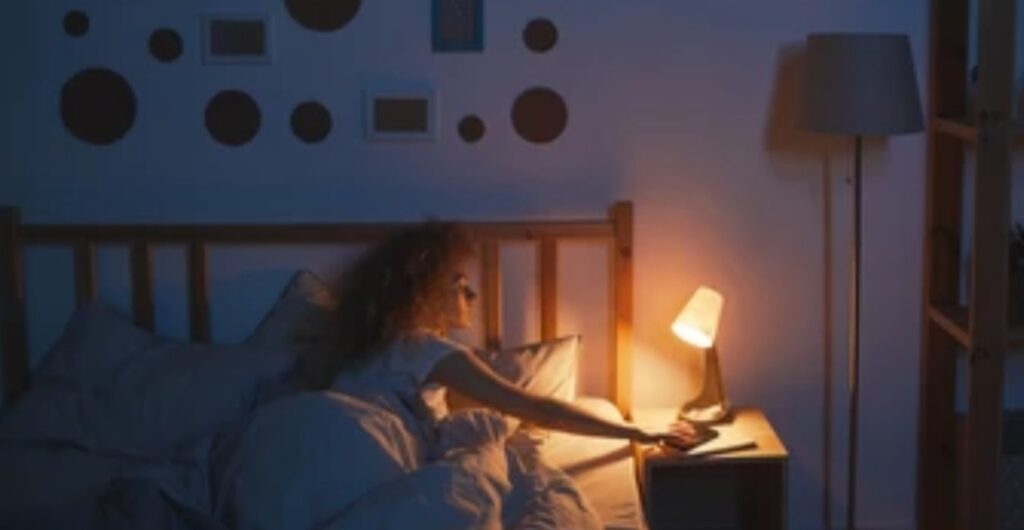
🌡️ Combine Smart Lighting With Other Smart Sleep Tech
Your lighting works even better when paired with other smart tools:
🛌 Try pairing with:
- Smart thermostats (cool your bedroom to 60–67°F)
- Sleep tracking apps that adjust light based on your sleep cycles
- Voice-controlled aromatherapy diffusers for calming scents
- Smart speakers with ambient noise or meditation tracks
📲 The more your devices “talk to each other,” the more seamless your sleep ritual becomes.
🧠 Think Beyond the Bedroom
Don’t limit smart lighting to the bedroom if your sleep struggles begin earlier in the evening.
💡 Optimize these areas too:
- 🛁 Bathroom: Use soft, amber lighting for your evening skincare routine
- 🍽️ Kitchen/Dining: Dim lights post-dinner to wind down stimulation
- 📺 Living Room: Add smart strips behind your TV to cut blue light exposure
Every space you use in the last 2 hours of your day can influence how fast you fall asleep.
⚡ Make Smart Lighting Your Secret Sleep Weapon
🧠 The right lighting can rewire your sleep habits and supercharge your mornings.
💡 Don’t settle for “just having smart lights.” Use these expert tips to get the most out of every bulb.
🔥 Try these smart lighting accessories and upgrades to build your ultimate sleep sanctuary.
❓ Frequently Asked Questions (FAQs)
Still have questions about how to set up smart lighting for better sleep?
You’re not alone.
This section answers the most common and searched-for questions related to smart lighting and sleep.
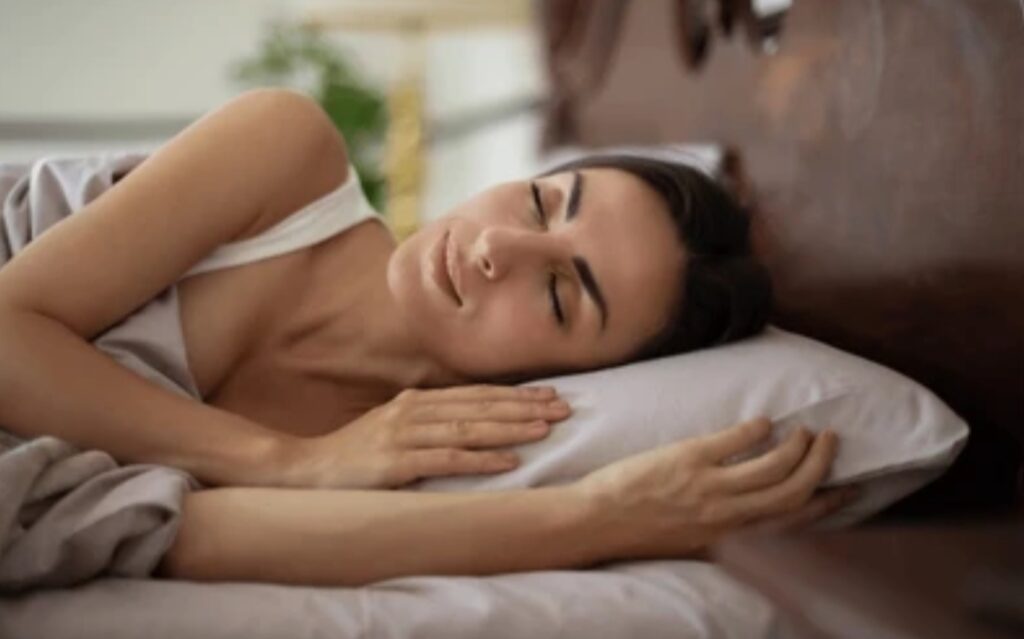
🔦 What is the best type of smart lighting for better sleep?
The best smart lighting for sleep is one that supports:
- Adjustable color temperature (especially warm/amber tones)
- Dimming capability
- Scheduling/automation
- Sunset simulation and circadian rhythm features
Top choices include:
- Philips Hue Smart Bulbs
- Govee RGBWW LED Smart Strips
- Wyze Color Bulbs
- Sengled Smart Wi-Fi LED
✅ Pro Tip: Always choose bulbs that allow full customization—especially during the 2 hours before bedtime.
🛏️ Where should I place smart lights to improve sleep?
Primary areas to install smart lighting for sleep optimization:
- 🛌 Bedroom ceiling light (main dimmable bulb)
- 🛏️ Bedside table lamp with a smart bulb
- 🚪 Entry light with motion detection
- 🌙 Under-bed LED strip (gentle indirect light for night navigation)
✅ Bonus: Add a smart light strip behind the headboard for soft ambient glow that doesn’t disrupt melatonin production.
🕒 When should smart lights start dimming for better sleep?
To align with your natural circadian rhythm, lights should:
- Begin dimming 90–120 minutes before your desired bedtime
- Shift to warm amber or red light at least 60 minutes before bed
- Fade out completely 5–10 minutes before sleep
📲 Use automation in your app or with routines via Google Home, Alexa, or Apple HomeKit.
📱 Can I control smart lighting with my phone while in bed?
Yes!
Most smart lighting systems come with mobile apps that allow:
- Manual brightness and color control
- Custom scheduling
- Scene creation (e.g., “Relax,” “Sleep Mode”)
- Grouping lights by room
✅ Tip: Enable voice control or install a bedside smart button to reduce screen use right before bed.
🔌 What if there’s a power outage—will my smart lighting reset?
Many smart bulbs revert to full brightness when power is restored—this can be disruptive during sleep hours.
✅ To prevent this:
- Choose bulbs that support “Power-On Behavior” settings (e.g., Philips Hue, LIFX)
- Set them to “Last State” or “Power Off” instead of “Default On”
- Consider using a UPS backup system for consistent lighting automation
🧠 Is smart lighting really effective for improving sleep?
Yes—according to multiple sleep studies and experts in chronobiology, light is one of the strongest external cues that influences your internal sleep-wake clock.
Proper smart lighting can:
- Regulate melatonin production
- Signal your brain when it’s time to wind down
- Help you fall asleep faster and wake up more naturally
✅ It’s most effective when combined with other sleep hygiene practices like limiting blue light exposure, keeping a consistent bedtime, and creating a cool, quiet sleep environment.
⏰ Should I use smart lighting as an alarm in the morning?
Absolutely.
This is called a wake-up light feature or sunrise simulation, and it’s proven to:
- Help regulate circadian rhythm
- Reduce morning grogginess
- Wake you more gently than traditional alarms
✅ Set your smart light to gradually brighten 30 minutes before your wake-up time using cool daylight tones (5000K–6500K).
🧠 Try combining this with soft morning music via your smart speaker for a holistic wake-up routine.

🏠 Do I need a smart home hub to use smart lights for sleep?
Not always.
Some brands (like Wyze and TP-Link Kasa) connect directly via Wi-Fi. Others (like Philips Hue or Zigbee-based bulbs) may require a hub for advanced features.
✅ Without a hub:
You still get basic scheduling and color control via app
✅ With a hub:
You unlock deeper integrations, better reliability, and wider automation options
🛡️ Is smart lighting safe to use in the bedroom?
Yes, smart lighting is safe for sleep spaces as long as:
- You choose bulbs certified for home use (UL or CE approved)
- Use low-EMF, low-heat LEDs
- Avoid flickering or poor-quality lights that could cause eye strain
✅ For ultra-safe nighttime use, look for amber or red spectrum LEDs, which have minimal blue light.
📣 Can smart lighting help kids or seniors sleep better?
Yes—customized smart lighting helps both children and older adults by:
- Creating predictable nighttime routines
- Reducing night-time stimulation
- Providing motion-sensitive night lights to prevent falls
✅ Kids benefit from gradual dimming, while seniors may benefit from motion-activated low-light strips under the bed or along the floor.
🧸 Choose kid-safe smart bulbs with a plastic build and easy parental controls.
⚡ Still Curious About Smart Lighting for Sleep?
🛏️ Don’t let questions keep you up at night.
💡 Explore trusted smart lighting brands and accessories to upgrade your sleep tonight.
🎯 Start your journey to better sleep—one bulb at a time.
🌙 Conclusion: Embracing Smart Lighting for Improved Sleep
In today’s hyper-connected, always-on world, quality sleep has become a luxury many struggle to afford.
But what if the secret to better rest wasn’t in a pill or pricey gadget—but as simple as the light in your room?
This comprehensive guide has walked you through exactly how to set up smart lighting for better sleep, step-by-step.
You’ve learned how lighting impacts your circadian rhythm, what type of smart lights work best for sleep, and how to create customized, automated lighting routines that naturally guide your brain into rest mode.
Smart lighting is not just about convenience or aesthetics—it’s a science-backed solution for those who want to fall asleep faster, stay asleep longer, and wake up feeling truly refreshed.

🛏️ Final Takeaways:
✅ Lighting is a biological signal. The wrong light at the wrong time disrupts sleep. The right light improves it.
✅ Smart lights empower you to personalize light temperatures, dimming levels, and schedules to align with your body’s needs.
✅ When paired with other sleep hygiene practices, smart lighting becomes a powerful wellness tool—not just a tech upgrade.
🎯 Ready to Take the First Step Toward Better Sleep?
💡 Don’t just read about how to sleep better—take action tonight.
👉 Explore top-rated smart bulbs and light strips for sleep
👉 Set up your first automated wind-down routine
👉 Invest in your rest—because your sleep is your superpower
⚡ Your journey to deeper, healthier, and more rejuvenating sleep starts with a single smart bulb. Make the switch today.
You might also like :

